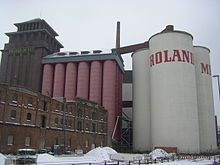Rolandmühle
The Rolandmühle in Bremen is an industrial grain mill that is considered one of the most important private production companies in the Bremen port industry. The company has around 100 employees and, according to its own information, processes 350,000 tons of grain annually into flour products for trade and industry. Imported grain and regional grain volumes are processed. Regional buyers and export customers are supplied.
history
In the course of the construction of Franz Köcheln's oil mill at the Stephanitor's bulwark , the master miller from Groningen brought several assistants with him, among whom the 30-year-old Berend Erling highlighted himself as "extremely skilled". He stayed in Bremen after the construction, was able to establish himself as a miller and had his first windmill built in 1832 . The Herdentorswallmühle still stands today as one of the last Bremen windmills in the ramparts . The Stephanitorsmühle followed in 1846, the upper part of which burned down in 1911; the lower part served as an apartment until 1930 and was only demolished when the tracks at the Weserbahnhof were renewed. His son Johann Erling took over the business and built the steam mill on Tannenstrasse in Vegesack in 1882 , which burned down in 1897.
After the first steam mill was destroyed and, with growing economic success, windmills were no longer sufficient, Carl Erling founded the Bremen Rolandmühle AG in 1897 to rebuild a large steam mill with a share capital of initially 1 million marks , which built and operated the Rolandmühle at the factory harbor in the port district . It had an output of 100 tons per day. The wheat required has now been imported from all over the world and the flour is sold by barge within Germany. Seagoing ships were used for overseas exports.
In the following years the mill was continuously expanded and its output increased to 800 tons per day. In 1925 the first silo tower was built according to a design by the Bremen architect Carl Heinrich Behrens-Nicolai and five years later another mill was taken over for the first time. In 1940 a second silo was inaugurated so that the Rolandmühle had a storage capacity of 30,000 tons.
After buying up competing companies such as Grohner Mühlenwerke and Hansamühle AG during the global economic crisis, Hans Erling, as a member of the board, converted Rolandmühle AG from Bremen back into a family business in 1937.
Destruction of the mill by blowing it up at the instigation of the Wehrmacht was prevented in 1945 towards the end of the Second World War .
In the early 1970s, a steel grain silo at Rolandmühle broke as a result of corrosion damage , and the unground grain spilled onto the street without further personal injury or property damage.
Flour dust explosion
Due to a fire accident on February 6, 1979, the company hit the headlines again. The cause was one of the strongest peacetime explosions in the world . A cable fire caused the most powerful flour dust explosion in German history in a sample chamber on the quay . From here the fire spread over a conveyor bridge with further small flour dust explosions along this bridge, which filled the upper flour storage area with flour dust. In this room, another small explosion triggered the catastrophe, which also set a flour silo on fire.
The roofs of the silos were torn up by the pressure wave, walls collapsed and entire buildings burst. Even further away from the mill, window panes broke in residential buildings and a rain of flour fell over an area of around 30 hectares . 14 people lost their lives in the detonations; 17 were injured, some seriously. The fire was completely extinguished after about 65 days. The accident caused property damage of more than 100 million DM, which today would correspond to around 116 million euros. The Rolandmühle was then completely rebuilt.
Situation today
Today the mill is equipped with modern silos, a total of twelve small and three large silos.
The mill is an important pillar of Bremen's port industry and a major employer in the neighboring districts. Most of the production is shipped nowadays. Around 360,000 tons of grain are processed in the mill annually (as of 2014). 100 to 200 ships dock right next to the silos.
The company is currently managed by Hans-Christoph Erling and Dieter Bohling.
In 2004 the company merged with two smaller companies. The three family companies Bremer Rolandmühle Erling, Mills United Hovestadt & Münstermann and Heyl-Mühlen merged in 2004 to form the Grain Millers association . The mill association has been operating under the name Roland Mills United since December 2013 .
Individual evidence
- ^ Handbook of German Stock Companies , 30th edition 1925, Volume 2, page 4207 f.
- ↑ Helmut R. Hoppe . In: Historical Society of Bremen, State Archive Bremen (Ed.): Bremische Biographie 1912–1962 . Verlag HM Hauschild, Bremen 1969, p. 140 f.
- ^ R. Eckhoff: Dust Explosions in the Process Industries 2nd edition. Butterworth-Heinemann, ISBN 0-7506-3270-4 , p. 157 ff.
- ↑ The cause of the explosion clarified. In: Hamburger Abendblatt. February 24, 1979
- ^ German fire brigade newspaper . Issue 2.1980
- ↑ Daniel Münter: Flour dust explosions - one spark is enough! In: Reinhart Brüning u. a .: Quarks & Co. - “Beware of the risk of explosion!” ( Memento from July 5, 2010 in the Internet Archive ) (PDF; 379 kB) p. 6. on: wdr.de
- ↑ This figure was based on the template: Inflation determined, rounded to a full million EUR and applies to the previous January.
- ↑ The Senator for Finance: Mayor Karoline Linnert visiting a district in the west of Bremen . Press release from August 15, 2014
- ↑ Imprint , accessed on October 28, 2016
- ^ Roland Mills United , accessed October 28, 2016
Web links
Coordinates: 53 ° 5 ′ 57.3 " N , 8 ° 46 ′ 23.3" E

